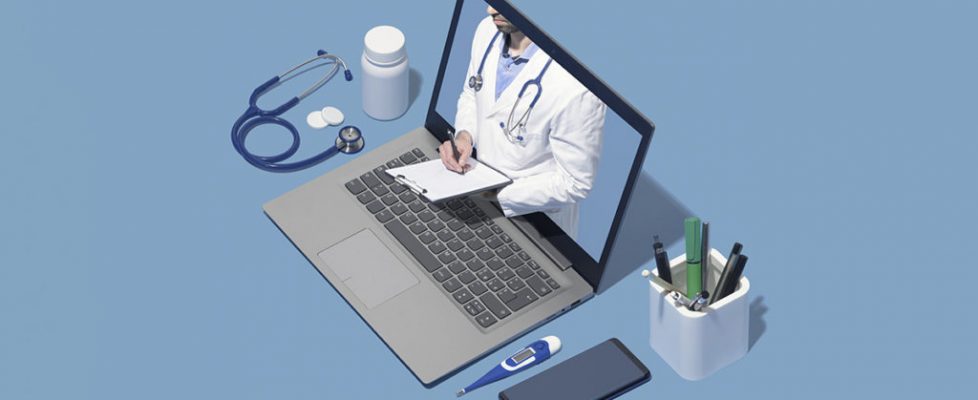Benefits to remote patient monitoring
With forethought and the right technology on board, remote patient monitoring can be a good complement to telehealth, allowing physicians to receive data about their patients’ in real time.
As the COVID-19 pandemic and shutdown kept people at home to avoid getting sick, especially those with chronic health conditions, experts recommended remote patient monitoring (RPM) as a solution to continuity of care. With forethought and the right technology on board, RPM can be a good complement to telehealth, allowing physicians to receive data about their patients’ in real time.
The most commonly used RPM devices track essential vital signs such as blood pressure, heart rate, blood glucose levels, oxygen saturation and temperature. There are also RPM devices for nervous system signals, weight, patient activity and sleep.
“As we gain more experience with RPM, we’ll figure out even more clinical conditions that it can help us with,” says Richard L. Seidman, M.D., MPH, chief medical officer of L.A. Care Health Plan.
In fact, his practice has been using RPM in a prenatal pilot to reduce the number of times pregnant women visit their doctor’s offices in person. Women in this pilot take their blood pressure and weigh themselves daily at home, then transmit that information to their doctors.
Physicians at the leading edge of RPM have adopted remote spirometry for to monitor patients with chronic obstructive pulmonary disease (COPD) and asthma, a population at high risk for COVID-19.
A big benefit RPM is that many systems don’t need to rely upon patient reporting their data. This is especially helpful for patients with conditions such as diabetes, which are subject to many incremental changes between physician visits. With RPM, crucial data can be transmitted to the doctor instantly, such as medication adherence and A1c.
RPM cannot replacein-person clinical visit, but it’s an essential tool alongside taking a good history, says Abe Malkin, M.D., MBA, founder and medical director of Concierge MD LA, a concierge practice.
“In primary care, once you have a really good history, you can almost make your determination. You use the physical exam to confirm that diagnosis. So [RPM] is sufficient to make diagnoses with a high level of comfort,” Malkin says. “It won’t replace in-person visits, but as we get more comfortable with it, it will give better access to care.”
Seidman adds that RPM is a great complement to telehealth, which is quickly becoming the standard for seeing patients during the COVID-19 pandemic.
Considerations for adopting RPM
For physicians who wish to begin adopting RPM or increase its usage in their practice, “the first thing is to define the highest yield monitoring that you think you need to do as part of your practice,” says Joel Klein, M.D., senior vice president and chief information officer at the University of Maryland Medical System in Baltimore. “Really define what problem you’re trying to solve.”
For physicians who have a large chronic care population, it may be wise to start with just one, he says.
Let’s say a physician chooses monitoring blood glucose. It’s important to use an RPM technology that allows a physician to see the big picture of the data, Klein says. “You need the ability to get insights from it.”
With insights, however, comes responsibility, Klein says. This RPM may show danger signals such as a patient who is hypoxic or with a dangerous blood sugar level. “What are you going to do with that information?” he asks. Physicians need to think about their obligation and how to set the patient up for success.
In order to access the RPM data, most physicians will need a telehealth platform that interfaces with their EHR. A physician’s vendor can help find the best platform to sync with the EHR, Malkin says.
Identifying the patient populations a physician will treat with RPM also is critical to narrowing the software or platform choice. “I would start with taking patients who feel their symptoms lend more to a telehealth exam,” Malkin says.
Additionally, Malkin suggests physicians look for RPM technology that is easy for patients to use at home, whether it be a blood pressure cuff, glucose monitor, pulse oximeter or another device.
RPM revenue benefits
RPM may offer an increased revenue stream for physicians whose income is negatively affected by COVID-19. Medicare waivers have made it possible for physicians to bill for services done remotelywithout having to bring patients in.
Additionally, many of the platforms may help physicians defray costs early on by taking a higher cut of the revenue, but eventually physicians can increase their revenue.
Physicians may not be aware of how many aspects of RPM are reimbursable, as well, says Adam Powell, Ph.D., president of Payer+Provider Syndicate, a Boston-based health care consulting firm.
RPM codes include:
Initial setup of the device and patient education: 99453.
An additional code that can be billed each 30 days for supplying the device: 99454.
20 minutes or more of clinical staff, physician or other qualified health professional time in a calendar month requiring interactive communication with the patient or caregiver: 99457.
Collection and interpretation of physiological data digitally stored and transmitted to the patient and/or caregiver, to the physician or qualified health professional: 99091.

